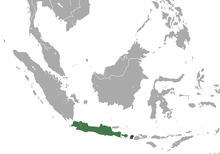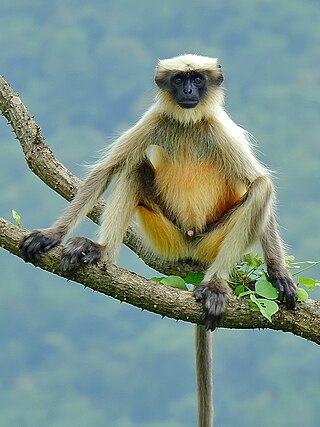
Semnopithecus is a genus of Old World monkeys native to the Indian subcontinent, with all species with the exception of two being commonly known as gray langurs. Traditionally only the species Semnopithecus entellus was recognized, but since about 2001 additional species have been recognized. The taxonomy has been in flux, but currently eight species are recognized.

The purple-faced langur, also known as the purple-faced leaf monkey, is a species of Old World monkey that is endemic to Sri Lanka. The animal is a long-tailed arboreal species, identified by a mostly brown appearance, dark face and a very shy nature. The species was once highly prevalent, found in suburban Colombo and the "wet zone" villages, but rapid urbanization has led to a significant decrease in the population level of the monkeys. It had traditionally been classified within the genus Trachypithecus but was moved to the genus Semnopithecus based on DNA evidence indicating that is it more closely related to the gray langurs.

The Colobinae or leaf-eating monkeys are a subfamily of the Old World monkey family that includes 61 species in 11 genera, including the black-and-white colobus, the large-nosed proboscis monkey, and the gray langurs. Some classifications split the colobine monkeys into two tribes, while others split them into three groups. Both classifications put the three African genera Colobus, Piliocolobus, and Procolobus in one group; these genera are distinct in that they have stub thumbs. The various Asian genera are placed into another one or two groups. Analysis of mtDNA confirms the Asian species form two distinct groups, one of langurs and the other of the "odd-nosed" species, but are inconsistent as to the relationships of the gray langurs; some studies suggest that the gray langurs are not closely related to either of these groups, while others place them firmly within the langur group.

Trachypithecus is a genus of Old World monkeys containing species known as lutungs, langurs, or leaf monkeys. Their range is much of Southeast Asia.

The Nilgiri langur is an Asian langur of the Old World monkey. It has glossy, black fur and an orangey-golden brown, hair-like mane on its head. Females have a white patch of fur on the inner thigh. It typically lives in troops of nine to ten individuals, with or without offspring, depending on seasonality. Its diet consists of fruits, shoots and leaves. It is listed as vulnerable on the IUCN Red List and is threatened by habitat destruction and poaching for its body parts, thought to supposedly contain aphrodisiac properties.

The Hatinh langur is a highly threatened Old World monkey found in limestone forests in Vietnam, primarily in the Quảng Bình Province. A recent survey discovered a small population living in the Quảng Trị Province. Contrary to its name, it is not known from the Hà Tĩnh Province. The local Van Kieu minority refer to this monkey as the 'Con Cung', which roughly translates as "black, cliff-dwelling monkey with a long tail". It resembles the closely related François' langur, but its white cheek-stripes typically extend behind the ears onto the nape, and the overall black colour is non-glossy and has a brownish tinge.

The silvery lutung, also known as the silvered leaf monkey or the silvery langur, is an Old World monkey. It is arboreal, living in coastal, mangrove, and riverine forests in Peninsular Malaysia, Sumatra, Borneo, Java, and other nearby islands. It is the type species of its species group.

The Tenasserim lutung is a species of Old World monkey. It is found in Myanmar and Thailand.
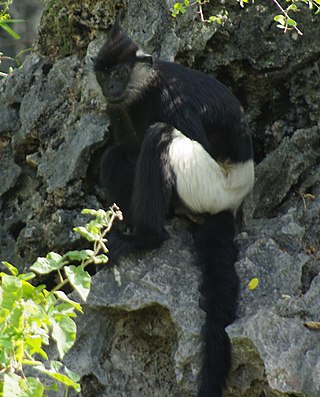
Delacour's langur or Delacour's lutung is a critically endangered species of Old World monkey endemic to northern Vietnam. It is named for French-American ornithologist Jean Théodore Delacour.

The Cat Ba langur, also known as the golden-headed langur, is a critically endangered species of langur endemic to Cát Bà Island, Vietnam. It is among the rarest primates in the world, and possibly the rarest primate in Asia, with population size estimated at less than 70 individuals.

Phayre's leaf monkey, also known as Phayre's langur, is a species of Old World monkey native to South Asia and Southeast Asia, namely India, Bangladesh, and Myanmar. Populations from further east are now thought to belong to other species. It is listed as Endangered on the IUCN Red List and is threatened by hunting and loss of habitat. The species epithet commemorates Arthur Purves Phayre.

The dusky leaf monkey, also known as the spectacled langur or the spectacled leaf monkey, is a species of primate in the family Cercopithecidae. It is found in Peninsular Malaysia, Myanmar and Thailand, and can occasionally be found in Singapore. During the day, these small, folivorous primates divide in sub-groups and forage for vegetation and fruit throughout the tropical forests. According to the IUCN, the dusky leaf monkey's population is declining due to habitat loss, poaching, and anthropogenic land use, which prompted the IUCN to classify the species as endangered in 2015.

Germain's langur is an Old World monkey native to Thailand, Myanmar, Cambodia, Laos and Vietnam. The monkey was previously included in Trachypithecus cristatus and Trachypithecus villosus.
The Indochinese black langur is a poorly known Old World monkey native to Laos and adjacent Vietnam. It was originally described as a subspecies of T. auratus, but was later found to be a member of the T. francoisi group, with some maintaining it as a subspecies of that species. In 2001, it was recommended treating it as a separate species.
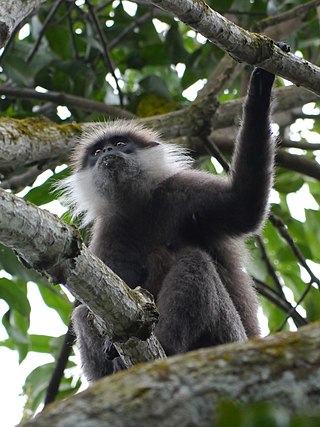
The western purple-faced langur, also known as the north lowland wetzone purple-faced langur, is a subspecies of purple-faced langur endemic to Sri Lanka. It lives in the wet zone in western Sri Lanka around the former capital city of Colombo. This subspecies are known to live in tropical rainforest, specifically in an area of Sri Lanka, where it is noted to rain two times more compared to the neighboring region. The subspecies is generally gray-brown with lighter whiskers, a gray rump patch, and dark forearms and legs. These monkeys also have dark brown or black, hairless faces. Their hands and feet are also hairless. When infants, their fur is medium brown to light gray, however it changes to their darker adult colors at between 12 and 16 weeks old. Typical length is between 48 and 67 centimetres excluding tail, with a 59 to 85 centimetres tail. On average, males weigh 8.5 kilograms (19 lb) and females weigh 7.8 kilograms (17 lb). Their average life span is about 26 years if the monkey was held in captivity. Due to their leafy diet, the western purple-faced langur back teeth, include high crowns and pointed cusps to make eating through greenery simpler. They also developed a digestive system that would allow them to break down cellulose in the leaves they eat. Although, leaves are their primary source of food, they also eat fruits and flowers. Female langurs hold a pregnancy for 195–210 days, and after the birth the offsprings are taken closely cared for by the mother until they are about 12–20 weeks old.

The Selangor silvered langur is a species of leaf monkey found on the west coast of Peninsular Malaysia. It had been previously considered a form of silvery lutung. Roos and colleagues elevated this population to a subspecies level, Trachypithecus cristatus selangorensis, in 2008. It has since come to be regarded by primatologists as a separate species, Trachypithecus selangorensis.

The West Javan langur is an Old World monkey from the Colobinae subfamily. It was formerly considered a subspecies of Trachypithecus auratus until it was elevated to a separate species by Roos and Groves. It is listed as vulnerable by the IUCN. Its range is restricted to the island of Java west of Jakarta. Its range is currently restricted to Ujung Kulon National Park, Muara Angke Wildlife Reserve and Muara Gembong due to industrial development, habitat fragmentation and the disconnection of protected areas. They are known to eat the leaves and fruits of Sonneratia in mangroves.

The Annamese langur is an Old World monkey from the Colobinae subfamily. It was formerly considered a subspecies of Trachypithecus germaini until it was elevated to a separate species by Roos and Groves in 2008. Its fur is lighter in colour than that of Trachypithecus germaini. Its range includes parts of Cambodia, Laos and Vietnam.
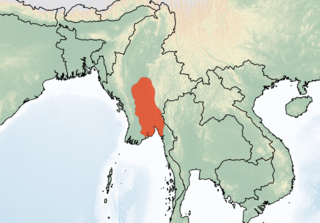
The Popa langur is a species of primate in the family Cercopithecidae. It occurs only in Myanmar and was named after Mount Popa, where a population of 100 of the monkeys live. It is listed as Critically Endangered on the IUCN Red List, as the wild population is thought to comprise 200 to 250 mature individuals.

The Indochinese grey langur is a species of Old World monkey native to East and Southeast Asia.

